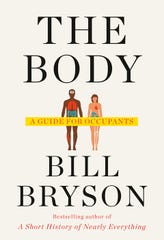Bryson on Our Bodies

Here’s a hypothetical question if there ever was one: What would it cost to create Benedict Cumberbatch from scratch – that is, to acquire the basic elements such as carbon, calcium and phosphorous that every human body contains?
Without such common ingredients all rolled into one, there would be no earlobes or kidneys, much less the actor’s high forehead or his hit BBC series “Sherlock.”
The Royal Society of Chemistry estimates that the tab would be nearly $70,000 to buy the materials to fashion a distinguished British thespian (or an obscure American book reviewer, for that matter). Another reputable source estimates the cost at $168.
There’s the rub, as author Bill Bryson points out early and often in his latest book, “The Body: A Guide to Occupants” (Doubleday, 464 pp., ★★★½ out of four stars). He writes, “[W]here the human body is concerned, the details are often surprisingly uncertain.”
Like an adventurer trekking the Appalachian Trail from beginning to end (as this bestselling author did for “A Walk in the Woods”), Bryson launches himself into the wilderness of the human anatomy armed with his characteristic thoroughness and wit. He ably dissects the knowns and unknowns of how we live and die and all the idiosyncrasies of our shared infrastructure.
Our bodies are, indeed, curious things. Among the unknowns are why we have earlobes, tonsils, unique whorls at the end of our digits that leave fingerprints, a gallbladder, an appendix and a uvula. We can do just fine without them (or that surplus kidney). If there is an “Intelligent Designer,” She needs to get to work on the Body Human 2.0.
Remarkably, no one has figured out why we sleep or have allergies or suffer from asthma, among myriad other biological mysteries. Of that last affliction, the author writes in an oft-repeated Byronic observation: “[N]o one knows much of anything.”
The author does interview a New Zealand academic who discovered that people who grew up with a cat in the house “seemed to derive lifelong protection from asthma.”
Scientists know much more than they once did about many things, from our tiny microbes and red blood cells (the body produces a million every second) to the brain and the heart; the last dispenses about 70 gallons of blood per hour every hour one lives. Humans have only one liver, but remove two thirds of it, and it will grow back, regenerating like the tail of a lizard. Now that’s amazing.
This book is full of such arresting factoids and, like a douser hunting water, Bryson is adept at finding the bizarre and the arcane in his subject matter. He writes, “Anton-Babinski syndrome, for instance, is a condition in which people are blind but refuse to believe it.” Or take this one: Americans are five times more likely to choke to death while eating than Britons. Your parents were right: Don’t bolt your food.
A cautionary note is in order. Sections of the book are not for the squeamish: for example, the blow-by-blow description of an operation on the 17th-century diarist Samuel Pepys to remove a gallstone the size of a tennis ball. There was no anesthetic, but rather four men holding the scribe down.
Bryson can wax serious, pointing out that Americans pay way more for their health care than anyone else, two-and-a-half times more than their counterparts in other developed nations. And the results are not impressive. Despite spending one-fifth of what they earn on health care, U.S. citizens rank 31st in life expectancy, behind countries such as Costa Rica and Chile. We do edge out Cuba and Albania.
Now that’s amazing.